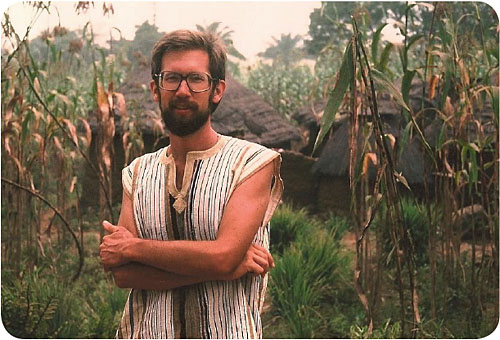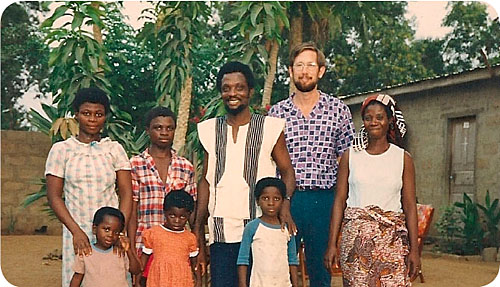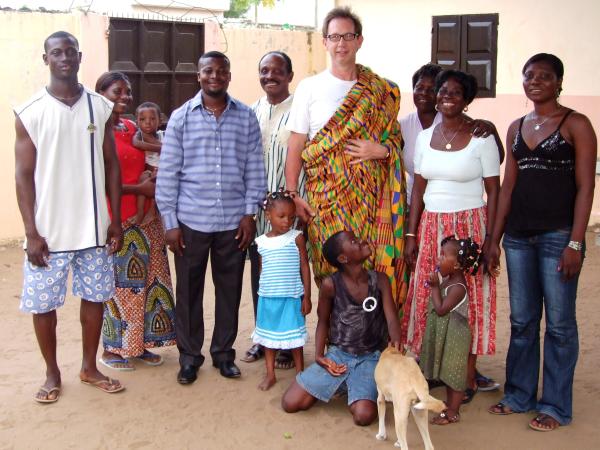 |
|
 Here I am as a young and idealistic Peace Corps volunteer in Togo in 1985. In the early 1980s, the Government of Togo decided to start a program to teach their students some practical skills that could help them in life in the event they could not find an office job. And so they decided to introduce agriculture into the secondary school curriculum. Only problem was, they didn’t have any qualified teachers to teach agriculture or the money to hire some. That’s where I came in. The Government of Togo asked Peace Corps to supply the teachers and Peace Corps recruited me. And, unlike the 20-some liberal arts graduates recruited for this program, I actually knew something about agriculture, having grown up on a beef, hog, corn and soybean farm in southwestern Minnesota. So I spent two years teaching agriculture in a secondary school in the village of Baguida near the beach just outside the Togolese capital of Lomé. I started a school garden and, later, a school library with funds from Friends of Togo and and a pig farm with support from Catholic Relief Services. I enjoyed my teaching role but I got the most satisfaction working with students who had started gardens at home. In addition to my main duties in the village, I was the editor of The Griot, the Peace Corps newsletter (I succeeded George Packer who later went on to literary fame as an author and staff writer for The New Yorker) and I helped train other volunteers who came after me. When I finished my Peace Corps service in June 1985, I was hired by Peace Corps Bénin to direct a training program there for incoming Peace Corps teachers. I never joined Peace Corps as a career move -- I meant to return to my chosen career of journalism or something like it -- but that is exactly what it became. Peace Corps was a turning point of my adult life and nothing was the same after my remarkable experience. On October 8, 1984, I wrote this in my diary: "It was one year ago that I first came to Baguida to begin my Peace Corps work. It has been a frustrating, challenging, stimulating and endlessly interesting year and never once have I ever regretted my decision to leave my comfortable life in the United States to come here to Togo." I still feel that way. At the end of my Peace Corps service in 1985, I wrote this essay for The Christian Science Monitor connecting my family’s history in agriculture with my Peace Corps career teaching agriculture (“An Olson Farms Again”. And I wrote this article on my Togo experience for the Anderson Independent newspaper in Anderson, S.C. (my last job in the U.S. before joining Peace Corps): Out Of Africa  Kofi Mawusi was the assistant headmaster of the school in Togo where I taught. Here I am with Kofi and his family at their home in Baguida in 1986...  ...and here I am in 2009 with the same family in the same house. |
|
In October 2009, I returned to my Peace Corps village for the first time in 23 years. Here is what I found. “David Jule Olson, a young and energetic American agriculture teacher, taught at the College d’Enseignement Général de Baguida from October 1983 to June 1985. He combined theory and practical agriculture so that in less than half a year, both students and teachers made their own backyard gardens where they grew vegetables, maize and cassava. Some of the teachers and students can now boast of eating three square meals a day. Some of them even sell the surplus food to earn extra money. The indefatigable agriculture teacher did not limit his work to the school but extended it to the whole area. He encouraged the use of organic manure rather than fertilizers which cost a lot of money to buy in Togo. He also started pig rearing at the school. I am pretty sure that in the near future the school will be self-sufficient in money matters because of the successful agricultural projects.” Kofi Mawusi, Assistant Director, College d’Enseignement, Baguida, Togo |
